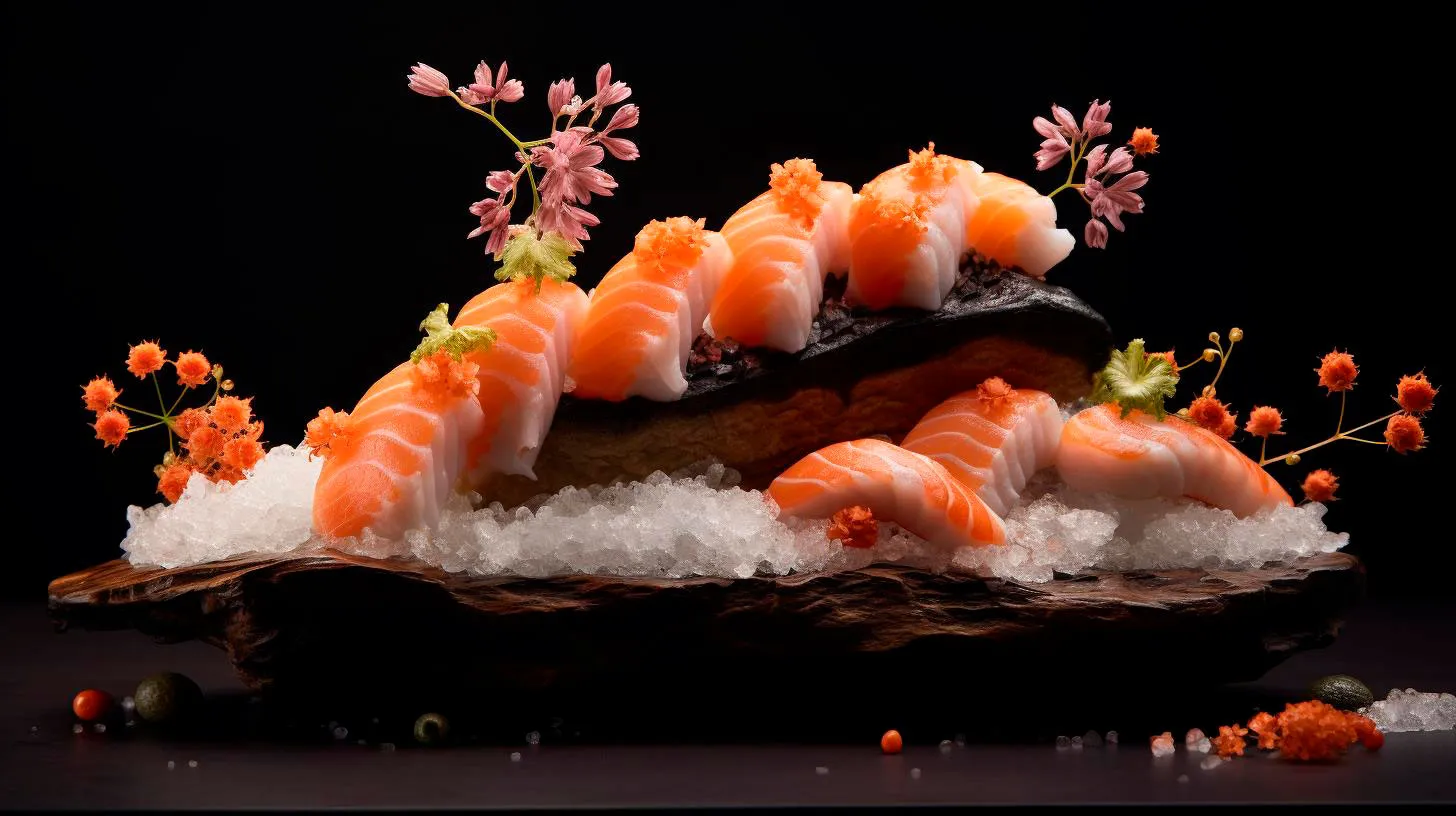DIY Sushi: Unleashing Your Inner Chef
Not only will you elevate your culinary skills, but you will also gain a deeper appreciation for sushi and have the freedom to customize your rolls to your liking. Let’s explore the world of DIY sushi and discover how you can create restaurant-quality sushi in the comfort of your own kitchen.
Benefits of DIY Sushi
Making sushi at home has a wide range of advantages over ordering it from a restaurant. Here are some compelling reasons why you should consider DIY sushi:
- Cost-effective: Sushi restaurants can be expensive, especially if you have a penchant for high-quality sushi. By making it at home, you can save money and still enjoy the same exquisite flavors.
- Customization: When you make your own sushi, you have the freedom to choose the ingredients and fillings you prefer. Whether you love spicy tuna or vegetarian options, you can create rolls that cater to your taste.
- Freshness: When you purchase sushi from a restaurant, you can never be certain of the freshness of the ingredients. By making it yourself, you have full control over the quality and freshness of each component.
- Healthier Option: By making sushi at home, you can control the amount of sodium, sugar, and other additives that are often found in restaurant-prepared sushi. It’s a healthier alternative without compromising on taste.
Key Ingredients and Equipment
Before you embark on your sushi-making journey, it’s important to gather the necessary ingredients and equipment. Here’s a list of what you’ll need:
- Sushi rice: A short-grain variety is ideal for sushi.
- Nori sheets: Thin, seaweed sheets used to wrap the sushi rolls.
- Sushi-grade fish or vegetables: Choose fresh and high-quality ingredients.
- Vegetables: Cucumber, avocado, carrot, and bell peppers are popular choices.
- Soy sauce, wasabi, and pickled ginger: Essential condiments for enjoying sushi.
- Bamboo rolling mat: Helps in rolling the sushi.
- Sharp knife: A sharp and non-serrated knife is crucial for clean cuts.
Step-by-Step Guide to Making Sushi
Now that you have gathered all the ingredients and equipment, let’s take a closer look at the step-by-step process of making sushi:
1. Prepare the Sushi Rice
Rinse sushi rice under cold water until the water runs clear. Cook the rice according to the package instructions. Once cooked, season it with a mixture of rice vinegar, sugar, and salt. Allow the rice to cool before using it for sushi.
2. Prepare the Fillings
Prepare your desired fillings, whether it’s slicing fish, julienning vegetables, or preparing spicy mayo. Be creative and experiment with different combinations to find your favorite flavors.
3. Assemble the Sushi
Place a sheet of nori on the bamboo rolling mat. Wet your hands to prevent the rice from sticking, then evenly spread a layer of sushi rice on the nori, leaving a small border at the top. Add your chosen fillings along the center of the rice.
4. Roll and Slice
Using the bamboo mat, carefully roll the sushi, applying slight pressure to keep it firm. Once rolled, use a sharp knife to slice the roll into bite-sized pieces. Ensure the knife is clean between each cut to maintain neat slices.
5. Serve and Enjoy
Arrange your sushi rolls on a plate. Serve with soy sauce, wasabi, and pickled ginger for an authentic sushi experience. Don’t forget to present your creations with flair!
Learn, Experiment, and Have Fun!
As with any skill, mastering the art of sushi-making takes practice. Don’t be discouraged if your first attempts aren’t perfect. Embrace the learning process and keep experimenting with different fillings, sauces, and presentation techniques. With time, you’ll develop the skills to create stunning and delicious sushi rolls that will impress your friends and family.
Remember, making DIY sushi is not only about the end result but also about the journey. Enjoy the process, experiment with flavors, and have fun unleashing your inner chef in the world of sushi making.
So, why not embark on this culinary adventure today? Step into your kitchen, gather the ingredients, and let your creativity shine as you dive into the fascinating world of DIY sushi!
Let Roll: Exploring the Art of Sushi Making
In this blog post, we will dive into the fascinating world of sushi, explore its origins, learn about the different types of sushi, and uncover the secrets behind creating this delectable culinary masterpiece.
The History and Origins of Sushi
Sushi, as we know it today, has a long and storied history dating back to ancient Japan. The original form of sushi was developed in Southeast Asia as a way to preserve fish by fermenting it with rice. Over time, this preservation method evolved, and the rice was consumed along with the fish.
It wasn’t until the 17th century that sushi made its way to Tokyo and underwent significant changes. Vinegar was introduced to the rice to enhance its flavor and act as a natural preservative. This technique, known as “nigiri sushi,” is still prevalent today.
The Different Types of Sushi
Sushi comes in many different forms, each with its unique preparation method and ingredients. Some notable types of sushi include:
- Nigiri Sushi: This is the most commonly recognized form of sushi, consisting of a small hand-formed mound of rice topped with a slice of raw or cooked fish.
- Maki Sushi: Maki sushi, or sushi rolls, are made by wrapping a sheet of seaweed (nori) around a combination of rice, fish, and vegetables. These rolls are then sliced into bite-sized pieces.
- Sashimi: Although technically not sushi, sashimi is a popular Japanese delicacy. It consists of thin slices of raw fish or seafood served without rice. The freshness and quality of the fish are crucial in sashimi preparation.
The Secrets Behind Sushi Making
Sushi making is often seen as an art form that requires precision, skill, and attention to detail. Here are some key secrets to creating perfect sushi:
- Quality of Ingredients: The quality of ingredients, especially the fish, makes all the difference in sushi. Freshness, flavor, and texture of the fish are key considerations.
- Rice Preparation: Achieving the perfect sushi rice is crucial. It should be sticky enough to hold its shape but not overly mushy. Vinegar, sugar, and salt are mixed into the rice to give it a distinctive flavor.
- Knife Skills: Sushi chefs undergo years of training to master the art of cutting fish. The precise knife cuts ensure that the flavors and textures are perfectly balanced.
- Presentation: Sushi is known for its beautiful presentation. Chefs pay attention to color, arrangement, and garnishes to create visually appealing sushi.
The Benefits of Sushi
Sushi not only tantalizes your taste buds but also offers several health benefits. These include:
- Omega-3 Fatty Acids: Fish used in sushi is an excellent source of omega-3 fatty acids, which are essential for brain health and reducing the risk of heart disease.
- Low in Calories: Sushi can be a low-calorie meal option, especially when opting for sashimi or rolls with lean fish and vegetables.
- Rich in Antioxidants: Sushi often includes ingredients like seaweed and vegetables, which are rich in antioxidants that help fight inflammation and support overall health.
Key Takeaways
Now that you have delved into the world of sushi making, here are the key takeaways:
- Sushi has a rich history with origins in Southeast Asia and further development in Japan.
- There are various types of sushi, including nigiri sushi, maki sushi, and sashimi.
- Quality of ingredients and precision in preparation are essential for creating exceptional sushi.
- Sushi offers health benefits such as omega-3 fatty acids and antioxidants.
So the next time you enjoy a plate of sushi, take a moment to appreciate the craft that goes into each piece. Sushi making truly is an art form that has captivated taste buds for centuries. Dive in and explore the world of sushi—it’s an adventure for your senses!
Sushi Party: An Interactive Culinary Experience
In this article, we will explore the beauty of sushi parties, their advantages, and why they have become a trend in recent years.
The Joy of Sushi
Sushi has evolved from a traditional Japanese delicacy to a worldwide phenomenon. Its popularity can be attributed to the unique combination of flavors, textures, and artistry that goes into every roll. With a sushi party, you get to experience these delights first-hand, creating your own sushi masterpieces and exploring various ingredients and techniques.
Key takeaways:
- Sushi parties provide a hands-on experience that allows participants to become sushi chefs for the day.
- They offer a wide variety of flavors and textures, providing something for everyone’s palate.
- Sushi parties are a fun and interactive way to learn about Japanese culture and culinary traditions.
Advantages of a Sushi Party
Hosting a sushi party brings numerous advantages that go beyond just enjoying delicious food. It offers a unique social experience where friends and family can bond over the art of sushi making. Here are some advantages of organizing a sushi party:
1. Creativity:
With a wide range of sushi fillings, toppings, and sauces available, you can let your creativity flow. Experiment with different combinations and flavors to create personalized sushi rolls that suit your taste. Whether you prefer traditional flavors or want to try something adventurous, the possibilities are endless.
2. Interactive Learning:
Sushi parties provide an opportunity to learn about the rich history, culture, and techniques behind sushi making. Professional sushi chefs can guide you through the process, sharing tips and tricks along the way. Gain insight into the art of rolling sushi, cutting precise slices, and presenting your creations with aesthetic flair.
3. Healthy and Nutritious:
Sushi is known for its health benefits, being low in fat and rich in omega-3 fatty acids. By hosting a sushi party, you can ensure that your guests have access to fresh ingredients, enabling them to customize their rolls according to their dietary preferences. Additionally, sushi is often packed with nutritious vegetables, making it a well-balanced meal option.
4. A Memorable Experience:
Unlike traditional dinner parties, a sushi party offers a unique and interactive experience that will leave a lasting impression on your guests. The process of making sushi together fosters a sense of camaraderie and creates memories that can be cherished for years to come.
The Rise of Sushi Parties
Sushi parties have gained significant popularity in recent years, attracting both sushi enthusiasts and those looking for a distinctive culinary experience. According to industry statistics:
- The global sushi market was valued at $14.98 billion in 2020 and is projected to reach $22.78 billion by 2027.
- The increasing demand for healthy food options and unique dining experiences has contributed to the growth of sushi parties.
- Interactive culinary experiences, like sushi parties, have become a key trend in the food and beverage industry.
With the growth of social media and the food blogging industry, sushi parties have become a popular subject for influencers and food enthusiasts. Posting pictures and sharing experiences from these events further contributes to their popularity and serves as a great way to showcase culinary skills and creativity.
Conclusion
A sushi party is an engaging and interactive culinary experience that combines the joy of sushi with the thrill of creating your own masterpieces. From the benefits of customization to the opportunity for hands-on learning, sushi parties offer a unique and memorable way to enjoy this beloved cuisine.
So why not gather your friends, roll up your sleeves, and embark on an unforgettable sushi adventure? Explore the flavors, unleash your creativity, and immerse yourself in the art of sushi-making with a sushi party!
Sushi Fun: Elevate Your Gatherings with DIY Sushi
With a few basic ingredients and a little practice, you can become a sushi master, impressing your friends and family with homemade sushi rolls. In this article, we will explore the art of DIY sushi, its benefits, and key takeaways to help you perfect this culinary delight.
Benefits of DIY Sushi
- Creative Freedom: When you make your own sushi, you have complete control over the ingredients, allowing you to customize your rolls according to your preferences. You can experiment with various combinations of fish, vegetables, and seasonings, creating unique flavors that will tantalize your taste buds.
- Health Conscious: DIY sushi allows you to choose fresh, high-quality ingredients, ensuring that you serve a nutritious and healthy meal to your guests. Sushi is known for its low-fat content, high protein levels, and abundance of vitamins and minerals.
- Cost-effective: Sushi restaurants can be expensive, especially when you’re hosting a large gathering. By making your own sushi, you can save money while still enjoying the same flavors and experience. Plus, you can make larger quantities of sushi for a fraction of the price.
- Social Experience: DIY sushi is not only about the food; it’s also a fantastic social activity. Get your friends involved, and have a sushi-making competition or a DIY sushi party. It’s a fun way to bond with your loved ones and create unforgettable memories.
Key Takeaways for DIY Sushi
Now that you understand the benefits of DIY sushi, let’s dive into some key takeaways to help you become a sushi pro:
1. Equipment & Ingredients
In order to make sushi at home, you’ll need a few essential tools:
- A bamboo sushi mat to roll the sushi.
- Sushi-grade fish or vegetables of your choice.
- Seaweed (nori) sheets.
- Sushi rice (short-grain rice).
- Variety of sauces and seasonings such as soy sauce, wasabi, and pickled ginger.
2. Perfecting Sushi Rice
Sushi rice is the foundation of any good sushi. To achieve the perfect texture and taste, follow these steps:
- Rinse the rice thoroughly to remove excess starch.
- Cook the rice according to the package instructions.
- Mix rice vinegar, sugar, and a pinch of salt, and gently fold it into the cooked rice while it’s still warm.
- Let the rice cool to room temperature, ensuring it remains sticky yet fluffy.
3. Mastering Sushi Rolling Techniques
Rolling sushi may seem intimidating, but with a little practice, you’ll become a pro. Remember these tips:
- Place the bamboo mat on a flat surface and cover it with plastic wrap.
- Spread a thin layer of sushi rice evenly over the nori sheet, leaving a small border at the top.
- Add your desired fillings horizontally across the rice.
- Use the bamboo mat to tightly roll the nori sheet, applying gentle pressure.
- Moisten the border with water to seal the roll.
- Using a sharp knife, cut the roll into bite-sized pieces.
Conclusion
DIY sushi is a fantastic way to elevate your gatherings and impress your guests with your culinary skills. By making your own sushi, you have the freedom to experiment with flavors, ensure quality ingredients, and save money. Additionally, the process of making sushi can be a fun and social activity. So why not gather your friends and family and embark on a DIY sushi adventure? With the right equipment, ingredients, and a little practice, you’ll be rolling out delicious sushi rolls in no time.



